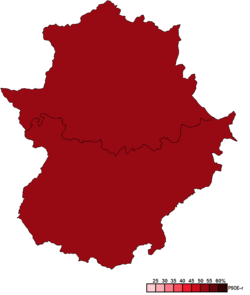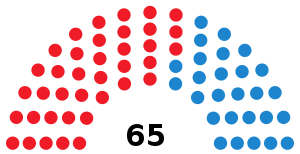2007 Extremaduran regional election
The 2007 Extremaduran regional election was held on Sunday, 27 May 2007, to elect the 7th Assembly of the autonomous community of Extremadura. All 65 seats in the Assembly were up for election. The election was held simultaneously with regional elections in twelve other autonomous communities and local elections all throughout Spain.
| |||||||||||||||||||||||||||||||||||||||||||||
All 65 seats in the Assembly of Extremadura 33 seats needed for a majority | |||||||||||||||||||||||||||||||||||||||||||||
|---|---|---|---|---|---|---|---|---|---|---|---|---|---|---|---|---|---|---|---|---|---|---|---|---|---|---|---|---|---|---|---|---|---|---|---|---|---|---|---|---|---|---|---|---|---|
| Opinion polls | |||||||||||||||||||||||||||||||||||||||||||||
| Registered | 893,547 | ||||||||||||||||||||||||||||||||||||||||||||
| Turnout | 669,752 (75.0%) | ||||||||||||||||||||||||||||||||||||||||||||
| |||||||||||||||||||||||||||||||||||||||||||||
 Constituency results map for the Assembly of Extremadura | |||||||||||||||||||||||||||||||||||||||||||||
| |||||||||||||||||||||||||||||||||||||||||||||
Spanish Socialist Workers' Party (PSOE) leader Guillermo Fernández Vara, who replaced Juan Carlos Rodríguez Ibarra as his party's candidate after 25 years of rule in the region, went on to win a comfortable absolute majority with 38 out of 65 seats, almost equalling the party's best result in the region in 1991. The opposition People's Party (PP), which for this election ran in coalition with regionalist United Extremadura (EU) party, was unable to make any significant gains, winning 1 seat to 2003 but losing ground when compared with the combined PP-EU vote share of that year's election.
United Left (IU), for the first time in its history, was unable to meet the 5% party threshold either regionally or in any of the provinces and was left out of the Assembly, this being the only time that just two parties had parliamentary representation in the Extremaduran Assembly.
Overview
Electoral system
The Assembly of Extremadura was the devolved, unicameral legislature of the autonomous community of Extremadura, having legislative power in regional matters as defined by the Spanish Constitution and the Extremaduran Statute of Autonomy, as well as the ability to vote confidence in or withdraw it from a President of the Regional Government.[1] Voting for the Assembly was on the basis of universal suffrage, which comprised all nationals over eighteen, registered in Extremadura and in full enjoyment of their political rights.
The 65 members of the Assembly of Extremadura were elected using the D'Hondt method and a closed list proportional representation, with a threshold of 5 percent of valid votes—which included blank ballots—being applied in each constituency. Parties not reaching the threshold were not taken into consideration for seat distribution. Alternatively, parties failing to reach the threshold in one of the constituencies would also be entitled to enter the seat distribution as long as they ran candidates in both districts and reached 5 percent regionally. Seats were allocated to constituencies, corresponding to the provinces of Badajoz and Cáceres. Each constituency was entitled to an initial minimum of 20 seats, with the remaining 25 allocated among the constituencies in proportion to their populations.[1][2]
The electoral law provided that parties, federations, coalitions and groupings of electors were allowed to present lists of candidates. However, groupings of electors were required to secure the signature of at least 2 percent of the electors registered in the constituency for which they sought election. Electors were barred from signing for more than one list of candidates. Concurrently, parties and federations intending to enter in coalition to take part jointly at an election were required to inform the relevant Electoral Commission within ten days of the election being called.[2][3][4]
Election date
The term of the Assembly of Extremadura expired four years after the date of its previous election. Elections to the Assembly were fixed for the fourth Sunday of May every four years. The previous election was held on 25 May 2003, setting the election date for the Assembly on Sunday, 27 May 2007.[1][2][3][4]
The President of the Regional Government had the prerogative to dissolve the Assembly of Extremadura and call a snap election, provided that no motion of no confidence was in process, no nationwide election was due and some time requirements were met: namely, that dissolution did not occur either during the first legislative session or within the legislature's last year ahead of its scheduled expiry, nor before one year had elapsed since a previous dissolution under this procedure. In the event of an investiture process failing to elect a regional President within a two-month period from the first ballot, the Assembly was to be automatically dissolved and a fresh election called. Any snap election held as a result of these circumstances would not alter the period to the next ordinary election, with elected deputies merely serving out what remained of their four-year terms.[1][5][6]
Opinion polls
The table below lists voting intention estimates in reverse chronological order, showing the most recent first and using the dates when the survey fieldwork was done, as opposed to the date of publication. Where the fieldwork dates are unknown, the date of publication is given instead. The highest percentage figure in each polling survey is displayed with its background shaded in the leading party's colour. If a tie ensues, this is applied to the figures with the highest percentages. The "Lead" column on the right shows the percentage-point difference between the parties with the highest percentages in a given poll. When available, seat projections are also displayed below the voting estimates in a smaller font. 33 seats were required for an absolute majority in the Assembly of Extremadura.
- Color key:
Exit poll
| Polling firm/Commissioner | Fieldwork date | Sample size | Turnout | Lead | |||
|---|---|---|---|---|---|---|---|
| 2007 regional election | 27 May 2007 | N/A | 75.0 | 53.0 38 |
38.7 27 |
4.5 0 |
14.3 |
| Ipsos/RTVE–FORTA[p 1][p 2] | 27 May 2007 | ? | ? | ? 35/38 |
? 24/27 |
? 2/3 |
? |
| Celeste-Tel/Terra[p 3][p 4] | 9–15 May 2007 | ? | ? | 50.9 34/35 |
39.8 27/28 |
6.2 3 |
11.1 |
| TNS Demoscopia/Antena 3[p 5] | 14 May 2007 | ? | ? | ? 35/37 |
? 27/29 |
? 0/2 |
? |
| Opinòmetre/El Periódico[p 6] | 10–14 May 2007 | ? | ? | ? 33/34 |
? 27/28 |
? 4/5 |
? |
| CEPS/PP[lower-alpha 2][p 7][p 8] | 8 May 2007 | 2,761 | 71.9 | 46.6 30/31 |
48.5 32/33 |
4.9 2/3 |
1.9 |
| Sigma Dos/El Mundo[p 9][p 10] | 27 Apr–8 May 2007 | 700 | ? | 50.1 34/36 |
42.3 29/31 |
3.4 0 |
7.8 |
| CIS[p 11][p 12] | 9 Apr–6 May 2007 | 1,199 | ? | 52.1 35 |
39.0 27 |
6.0 3 |
13.1 |
| Synovate/PSOE[p 13][p 14] | 27 Apr 2007 | 1,000 | ? | 50.3– 52.0 34/35 |
41.0– 41.6 27/28 |
5.5 2/3 |
9.3– 10.4 |
| Investiga/Canal Extremadura[p 15] | 10–23 Apr 2007 | 1,021 | ? | ? 38/39 |
? 23/24 |
? 3/4 |
? |
| CEPS/PP[lower-alpha 2][p 16][p 17] | 17 Apr 2007 | 1,100 | 69.8 | 48.3 31 |
46.7 31 |
5.0 3 |
1.6 |
| Opina/PSOE[p 18][p 19][p 20] | 25–29 Nov 2006 | 1,200 | ? | 50.1 35 |
40.8 29 |
5.0 1 |
9.3 |
| Sigma Dos/El Mundo[p 21][p 22][p 23] | 16–24 Nov 2006 | ? | ? | 49.3 33/35 |
41.4 27/29 |
5.5 3 |
7.9 |
| Opinòmetre/El Periódico[p 24] | 2–10 Nov 2006 | ? | ? | ? 32/33 |
? 29/30 |
? 3 |
? |
| Synovate/PSOE[p 25][p 26] | 8–10 Mar 2006 | 813 | ? | 51.1 36 |
40.5 27 |
5.2 2 |
10.6 |
| 2004 EP election | 13 Jun 2004 | N/A | 49.5 | 52.2 35 |
43.2 30 |
2.6 0 |
9.0 |
| 2004 general election | 14 Mar 2004 | N/A | 79.3 | 51.2 35 |
42.4 30 |
3.5 0 |
8.8 |
| 2003 regional election | 25 May 2003 | N/A | 75.6 | 51.7 36 |
38.7 26 |
6.3 3 |
13.0 |
Results
Overall
 | ||||||
| Parties and coalitions | Popular vote | Seats | ||||
|---|---|---|---|---|---|---|
| Votes | % | ±pp | Total | +/− | ||
| Spanish Socialist Workers' Party–Regionalists (PSOE–regionalistas) | 352,342 | 53.00 | +1.34 | 38 | +2 | |
| People's Party–United Extremadura (PP–EU)1 | 257,392 | 38.71 | –1.83 | 27 | +1 | |
| United Left–Independent Socialists of Extremadura (IU–SIEx) | 30,028 | 4.52 | –1.75 | 0 | –3 | |
| Independents for Extremadura (IPEx) | 8,389 | 1.26 | New | 0 | ±0 | |
| The Greens of Extremadura (LV) | 4,082 | 0.61 | New | 0 | ±0 | |
| Extremaduran People's Union (UPEx) | 1,520 | 0.23 | New | 0 | ±0 | |
| Living Initiative (IH) | 958 | 0.14 | New | 0 | ±0 | |
| Communist Party of the Peoples of Spain (PCPE) | 903 | 0.14 | New | 0 | ±0 | |
| Citizens for Blank Votes (CenB) | 499 | 0.08 | New | 0 | ±0 | |
| Democratic and Social Centre (CDS) | 445 | 0.07 | New | 0 | ±0 | |
| Humanist Party (PH) | 370 | 0.06 | –0.10 | 0 | ±0 | |
| Blank ballots | 7,926 | 1.19 | –0.18 | |||
| Total | 664,854 | 65 | ±0 | |||
| Valid votes | 664,854 | 99.27 | +0.08 | |||
| Invalid votes | 4,898 | 0.73 | –0.08 | |||
| Votes cast / turnout | 669,752 | 74.95 | –0.68 | |||
| Abstentions | 223,795 | 25.05 | +0.68 | |||
| Registered voters | 893,547 | |||||
| Sources[7][8] | ||||||
Aftermath
| Investiture Guillermo Fernández Vara (PSOE) | ||
| Ballot → | 27 June 2007 | |
|---|---|---|
| Required majority → | 33 out of 65 | |
37 / 65 | ||
27 / 65 | ||
| Abstentions | 0 / 65 | |
1 / 65 | ||
| Sources[8] | ||
References
- Opinion poll sources
- "Sólo Navarra y Baleares podrían cambiar de gobierno, según el sondeo de RTVE y FORTA". Europa Press (in Spanish). 27 May 2007.
- "Las "israelitas" no aclaran el futuro político de Guadalajara". La Crónica de Guadalajara (in Spanish). 27 May 2007.
- "Vuelco electoral en Navarra, Baleares y Canarias y aplastante victoria del PP en Madrid". Terra (in Spanish). 17 May 2007. Archived from the original on 20 May 2007.
- "Encuestas autonómicas". Celeste-Tel (in Spanish). 17 May 2007. Archived from the original on 11 May 2009.
- "¿Cree que son fiables las encuestas electorales?". El Periódico de Extremadura (in Spanish). 15 May 2007.
- "Vara logra mayoría absoluta y PP e IU mejoran sus resultados". El Periódico de Extremadura (in Spanish). 20 May 2007.
- "Una encuesta del PP le da la victoria en Extremadura con una ventaja de 1,4 puntos por delante de PSOE". Europa Press (in Spanish). 8 May 2007.
- "Una encuesta encargada por el PP y realizada por buzoneo le da mayoría". El Periódico de Extremadura (in Spanish). 9 May 2007.
- "Sondeo de Sigma Dos: El PSOE mantendría sus comunidades si revalida las coaliciones". El Mundo (in Spanish). 13 May 2007.
- "Elecciones 27-M / Sondeo El Mundo-Sigma Dos". El Mundo (in Spanish). 12 May 2007.
- "Preelectoral elecciones autonómicas, 2007. CA de Extremadura (Estudio nº 2695. Abril-Mayo 2007)" (PDF). CIS (in Spanish). 11 May 2007.
- "La aritmética juega en contra del PSOE sólo en las islas Canarias". La Vanguardia (in Spanish). 12 May 2007.
- "Un nuevo sondeo del PSOE da a Vara mayoría con 34-35 escaños". El Periódico de Extremadura (in Spanish). 28 April 2007.
- "El PSOE da a conocer una encuesta en la que mantendría la mayoría absoluta". Hoy (in Spanish). 28 April 2007. Archived from the original on 5 May 2007.
- "Una nueva encuesta da mayoría absoluta al PSOE en la Asamblea". El Periódico de Extremadura (in Spanish). 5 May 2007.
- "Una encuesta del PP refleja un empate entre Vara y Floriano". El Periódico de Extremadura (in Spanish). 18 April 2007.
- "Empate con el PSOE en Extremadura". La Razón (in Spanish). 18 April 2007. Archived from the original on 6 May 2007.
- "Una encuesta del PSOE da a Vara mayoría absoluta". El Periódico de Extremadura (in Spanish). 24 December 2006.
- "Una encuesta del PSOE extremeño le da la mayoría absoluta en la región con 35 escaños, uno menos que en 2003". Europa Press (in Spanish). 25 December 2006.
- "La lluvia de sondeos ya ha calado". El Periódico de Extremadura (in Spanish). 11 May 2007.
- "El PP y el PSOE mantendrán sus gobiernos autonómicos, aunque los socialistas bajan". El Mundo (in Spanish). 27 November 2006.
- "El voto en las comunidades. Elecciones autonómicas 2007" (PDF). El Mundo (in Spanish). 27 November 2006.
- "Los socialistas, sin Ibarra, bajan pero mantienen la mayoría absoluta". El Mundo (in Spanish). 27 November 2006. Archived from the original on 4 November 2011.
- "El PSOE ganaría hoy las elecciones, pero sería dudosa la mayoría absoluta". El Periódico de Extremadura (in Spanish). 19 November 2006.
- "Una encuesta del PSOE le da otra victoria electoral en las elecciones". El Periódico de Extremadura (in Spanish). 6 May 2006.
- "Floriano recorta distancias con Ibarra, según un sondeo encargado por el PSOE". ABC (in Spanish). 6 May 2006.
- Other
- "Statute of Autonomy of Extremadura of 1983". Organic Law No. 1 of 25 February 1983. Official State Gazette (in Spanish). Retrieved 17 March 2017.
- "Assembly of Extremadura Elections Law of 1987". Law No. 2 of 16 March 1987. Official Journal of Extremadura (in Spanish). Retrieved 17 March 2017.
- "General Electoral System Organic Law of 1985". Organic Law No. 5 of 19 June 1985. Official State Gazette (in Spanish). Retrieved 28 December 2016.
- "Representation of the people Institutional Act". www.juntaelectoralcentral.es. Central Electoral Commission. Retrieved 16 June 2017.
- "Statute of Autonomy of Extremadura Reform of 1991". Organic Law No. 5 of 13 March 1991. Official State Gazette (in Spanish). Retrieved 8 April 2017.
- "Statute of Autonomy of Extremadura Reform of 1999". Organic Law No. 12 of 6 May 1999. Official State Gazette (in Spanish). Retrieved 8 April 2017.
- "Assembly of Extremadura election results, 27 May 2007. Badajoz and Cáceres" (PDF). www.juntaelectoralcentral.es (in Spanish). Electoral Commission of Extremadura. 7 June 2007. Retrieved 26 September 2017.
- "Assembly of Extremadura elections since 1983". historiaelectoral.com (in Spanish). Electoral History. Retrieved 26 September 2017.
.jpg)
.jpg)
